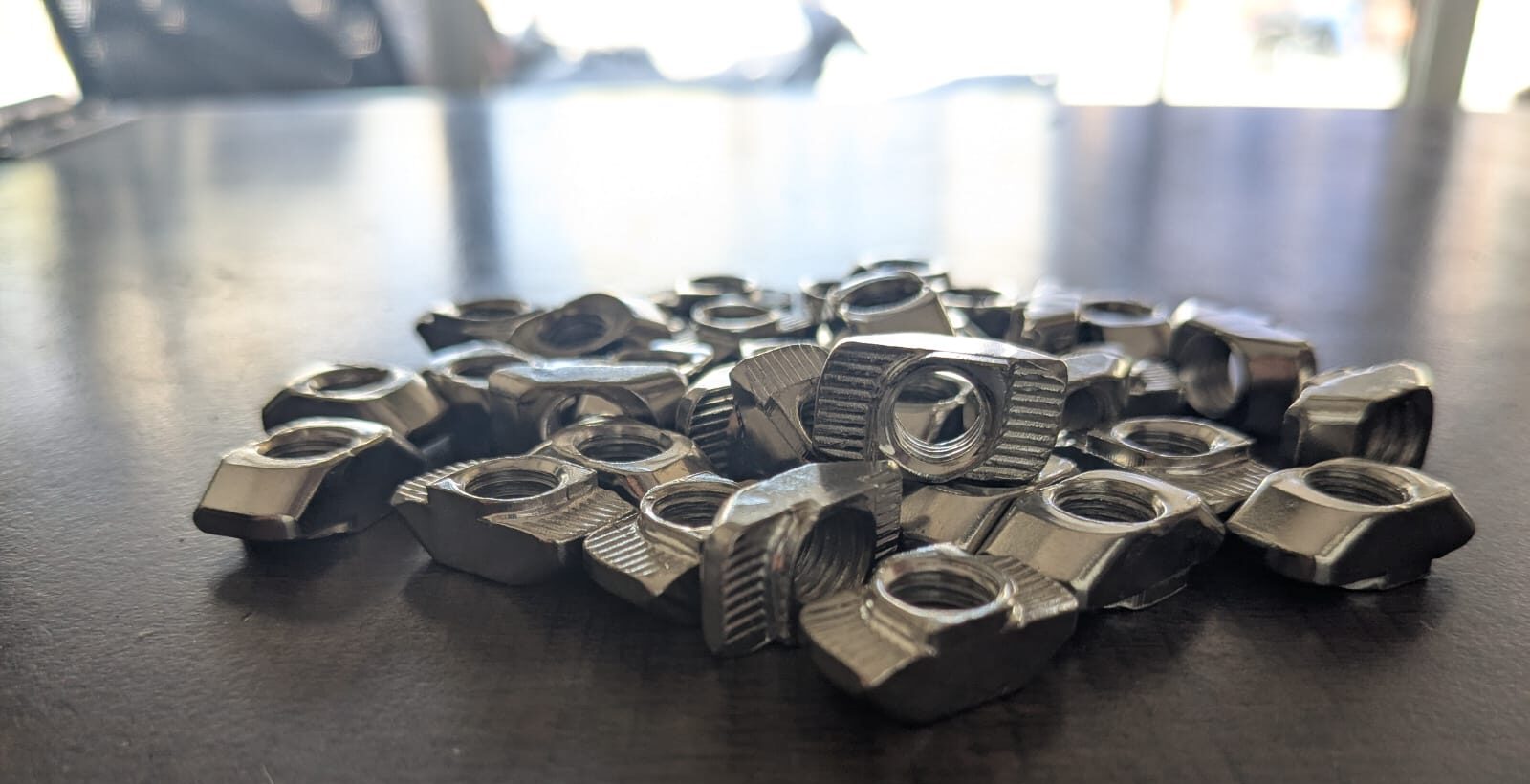Description
A T – Nut or Hammer Nut, also known as a drop-in T-nut or roll-in T-nut, is a specialized fastener designed to slide into the T-slot of aluminum extrusions. Unlike standard nuts, which require pre-insertion before assembly, hammer nuts can be inserted at any point along the T-slot, making modifications and adjustments significantly easier.
When a bolt is tightened into the hammer nut, it rotates and locks into place against the slot, ensuring a strong and stable connection.
Design and Components T – Nut or Hammer Nut
T – Nut or Hammer Nut typically consist of the following elements:
- Body: The main part of the nut, usually made of steel, stainless steel, or zinc-coated materials for durability.
- Threaded Hole: The central threaded section allows bolts or screws to be attached securely.
- Spring Ball or Leaf Spring (Optional): Some hammer nuts feature a built-in spring mechanism that keeps them in position during installation, preventing them from slipping out before fastening.
Materials Used
Hammer nuts are manufactured using various materials to suit different environmental conditions and load-bearing requirements:
- Steel (Carbon or Stainless Steel): Offers excellent strength and durability. Stainless steel variants provide corrosion resistance.
- Zinc-Plated Steel: Provides additional protection against oxidation and rust, making it suitable for moderate environments.
- Aluminum: Lightweight but not as strong as steel, typically used in non-load-bearing applications.
- Brass: Occasionally used for applications requiring electrical conductivity or corrosion resistance.
Types of T – Nut or Hammer Nut
Hammer nuts come in different shapes and sizes to accommodate various T-slot profiles. The common types include:
- Standard Hammer Nut: The most widely used type, available in multiple thread sizes and suitable for general-purpose applications.
- Spring-Loaded Hammer Nut: Equipped with a spring ball or leaf spring to hold it in place before securing the bolt.
- Heavy-Duty Hammer Nut: Designed for applications requiring higher load-bearing capacity.
- Self-Aligning Hammer Nut: Ensures proper positioning and alignment within the T-slot.
The choice of hammer nut depends on the specific requirements of the assembly, such as load capacity, ease of installation, and resistance to vibration.
Applications of T – Nut or Hammer Nut
T – Nut or Hammer Nut are widely used across various industries, including:
1. Industrial Automation and Machinery
- Used to assemble machine frames, conveyor systems, and robotic workstations.
- Facilitates easy repositioning and expansion of existing structures.
2. Workstations and Ergonomic Furniture
- Commonly found in modular workbenches, tool racks, and adjustable desks.
- Allows for quick customization and modifications.
3. DIY and Maker Projects
- Popular among hobbyists and makers for assembling 3D printer frames, CNC machines, and other custom-built structures.
- Provides a flexible and reusable fastening solution.
4. Solar Panel Mounting Systems
- Used to attach brackets and supports in photovoltaic mounting structures.
- Ensures a secure connection while allowing for easy adjustments.
5. Exhibition and Display Stands
- Ideal for modular display booths and trade show stands.
- Enables quick setup and breakdown without specialized tools.
Advantages of Using T – Nut or Hammer Nut
1. Easy Installation
One of the main benefits of hammer nuts is their tool-free insertion. Unlike traditional T-nuts that require sliding from the end of the extrusion, hammer nuts can be inserted anywhere along the profile, saving time and effort.
2. Reusability and Flexibility
Hammer nuts can be repositioned or removed without damaging the T-slot, making them ideal for applications requiring frequent modifications.
3. Strong and Secure Hold
Once tightened, the nut rotates and locks into the T-slot, preventing loosening due to vibrations or mechanical stress.
4. Cost-Effective
Compared to other fastening solutions, hammer nuts provide a strong yet economical way to create modular assemblies.
5. Compatibility
Hammer nuts are designed to work with various T-slot profiles, making them versatile for different extrusion systems.
Installation Process
Installing a T – Nut or Hammer Nut is a straightforward process:
- Position the Nut: Insert the hammer nut into the T-slot at the desired location.
- Align the Nut: Ensure the nut is properly positioned within the slot.
- Insert the Bolt or Screw: Thread a bolt or screw into the nut.
- Tighten the Bolt: As the bolt tightens, the nut rotates 90 degrees and locks against the slot, creating a firm grip.
- Check the Connection: Confirm that the nut is securely in place.
For installations involving multiple hammer nuts, it’s recommended to tighten each one gradually to maintain proper alignment.
For more products Click Here


Reviews
There are no reviews yet.